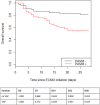Ventilator-associated pneumonia in patients assisted by veno-arterial extracorporeal membrane oxygenation support: Epidemiology and risk factors of treatment failure
- PMID: 29652913
- PMCID: PMC5898723
- DOI: 10.1371/journal.pone.0194976
Ventilator-associated pneumonia in patients assisted by veno-arterial extracorporeal membrane oxygenation support: Epidemiology and risk factors of treatment failure
Abstract
Introduction: Ventilator-associated pneumonia (VAP) is frequent in Intensive Care Unit (ICU) patients. In the specific case of patients treated with Veno-Arterial Extracorporeal Membrane Oxygenation Support (VA-ECMO), VAP treatment failures (VAP-TF) have been incompletely investigated.
Methods: To investigate the risk factors of treatment failure (VAP-TF) in a large cohort of ICU patients treated with VA-ECMO, we conducted a retrospective study in a Surgical ICU about patients assisted with VA-ECMO between January 1, 2013, and December 31, 2014. Diagnosis of VAP was confirmed by a positive quantitative culture of a respiratory sample. VAP-TF was defined as composite of death attributable to pneumonia and relapse within 28 days of the first episode.
Results: In total, 152 patients underwent ECMO support for > 48h. During the VA-ECMO support, 85 (55.9%) patients developed a VAP, for a rate of 60.6 per 1000 ECMO days. The main pathogens identified were Pseudomonas aeruginosa and Enterobacteriaceae. VAP-TF occurred in 37.2% of patients and was associated with an increased 28-day mortality (Hazard Ratio 3.05 [1.66; 5.63], P<0.001), and VA-ECMO assistance duration (HR 1.47 [1.05-2.05], P = 0.025). Risk factors for VAP-TF were renal replacement therapy (HR 13.05 [1.73; 98.56], P = 0.013) and documentation of Pseudomonas aeruginosa (HR 2.36 [1.04; 5.35], P = 0.04).
Conclusions: VAP in patients treated with VA-ECMO is associated with an increased morbidity and mortality. RRT and infection by Pseudomonas aeruginosa appear as strong risks factors of treatment failure. Further studies seem necessary to precise the best antibiotic management in these patients.
Conflict of interest statement
Figures
References
-
- Karagiannidis C, Brodie D, Strassmann S, Stoelben E, Philipp A, Bein T, et al. Extracorporeal membrane oxygenation: evolving epidemiology and mortality. Intensive Care Med. 2016;42: 889–896. doi: 10.1007/s00134-016-4273-z - DOI - PubMed
-
- Cheng R, Hachamovitch R, Kittleson M, Patel J, Arabia F, Moriguchi J, et al. Complications of extracorporeal membrane oxygenation for treatment of cardiogenic shock and cardiac arrest: a meta-analysis of 1,866 adult patients. Ann Thorac Surg. 2014;97: 610–616. doi: 10.1016/j.athoracsur.2013.09.008 - DOI - PubMed
-
- Sun H-Y, Ko W-J, Tsai P-R, Sun C-C, Chang Y-Y, Lee C-W, et al. Infections occurring during extracorporeal membrane oxygenation use in adult patients. The Journal of Thoracic and Cardiovascular Surgery. 2010;140: 1125–32.e2. doi: 10.1016/j.jtcvs.2010.07.017 - DOI - PubMed
-
- Bizzarro MJ, Conrad SA, Kaufman DA, Rycus P, Extracorporeal Life Support Organization Task Force on Infections, Extracorporeal Membrane Oxygenation. Infections acquired during extracorporeal membrane oxygenation in neonates, children, and adults. Pediatric Critical Care Medicine. 2011;12: 277–281. doi: 10.1097/PCC.0b013e3181e28894 - DOI - PubMed
-
- Schmidt M, Bréchot N, Hariri S, Guiguet M, Luyt C-E, Makri R, et al. Nosocomial infections in adult cardiogenic shock patients supported by venoarterial extracorporeal membrane oxygenation. Clin Infect Dis. 2012;55: 1633–1641. doi: 10.1093/cid/cis783 - DOI - PMC - PubMed
MeSH terms
LinkOut - more resources
Full Text Sources
Other Literature Sources
Miscellaneous


